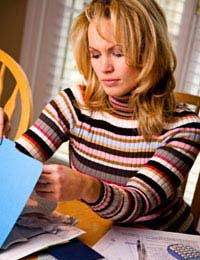Creating a Divorce Budget

If you are divorcing from your partner you will need to provide a breakdown of all your earning and spending plus your complete current financial position, to the court. It is one of the first things your solicitor will ask you to do. You will also find creating a budget helpful personally. It should be at the top of your list of priorities.
Making a Cash Flow Statement
There are two parts to the budget process: listing your income and expenses, and detailing your financial position. You should make a start with your annual cash flow statement. Firstly, list any income you receive in a year, including your salary, benefits and investments. Then you should make a list of all of your expenses. Divide them into:- Fixed outflows such as mortgage, utility bills and taxes that must be paid on time.
- Variable costs like food, travel, clothing, child care and holidays.
- Savings and investments, including pensions, ISAs and savings for emergencies.
Budget PlannerINCOME£…… Salary £…… Benefits Etc. £…… Total Income EXPENSES – FIXED EXPENSES – VARIABLE SAVINGS AND INVESTMENTS |
Once you have calculated all your income and expenses, you should add the sub-totals of the three outgoings together to make ‘Total Expenses’.
Finally, subtract your ‘Total Expenses’ from your ‘Total Income’ to give the final ‘Balance’ of your year’s earning and spending.
If Your Cash Flow Statement is Inaccurate
If there are discrepancies between the figures arrived at in your cash flow statement and how much you actually have in the bank or in your hand at the end of a month or year, you should check what is missing from your statement. Perhaps ask a family member or friend to double-check it for you.If you are really having trouble making the cash flow statement match up with reality, there is one solution that every financial guru eventually recommends. You must audit your expenditure. This means that for one month you carry a pen and notepad and write down every item you spend money on. You will probably find all sorts of small items adding up to the shortfall between your estimate and your actual balance.
Working Out Your Financial Position
Once you have created an annual budget, you will need to work out your financial position or balance sheet. Where as the budget shows your position over a period of time, a balance sheet is a snapshot at a specific date. It includes all your family’s assets and liabilities and tells you how much you and your partner are worth. It will enable you to see what assets and capital there are to be divided and any shared debts or other commitments that will need to be deducted.The structure should be as follows:
Statement of financial position as of date:
| CASH & CASH EQUIVALENT ASSETS £…… Building society accounts £…… Bank accounts £…… Tessas, ISAs, other savings Etc. £…… Total Cash & Cash Equivalents INVESTING ASSETS USED ASSETS PENSION ASSETS £…… TOTAL ASSETS TOTAL LIABILITIES NET WORTH £…… Total Assets minus Total Liabilities |
Note: Pensions are calculated at current cash equivalent transfer value.
- Divorce and Your Finances: How to Preserve Your Position
- Can You Afford a Divorce?
- Changing Insurance Policies Following Divorce
- What Will Happen to Your Pension?
- Paying Joint Debts
- Protecting Your Assets in a New Relationship
- Creating a Post-Divorce Budget
- Financial Help for People on Low Incomes
- Welfare Benefits
- Financial Implications of Divorce
- Short-Term Divorce Plan


Re: Can I Legally Force My Ex to Sell Our Property?
I have a court order for my husband to sell our house after our divorce and he is refusing to sell. Is…
Re: A Partner Who is Addicted to Alcohol or Drugs
Same here, thank you DaphneM for your recommendation. Ellen Petersen's guide helped me approach the problem…
Re: A Partner Who is Addicted to Alcohol or Drugs
Thank you DaphneM for recommending a guide by Ellen Petersen and sharing the link. I was completely…
Re: Getting Help with Property
I want to leave my husband and I have started to work two jobs to afford paying rent on my own. I work at a school and in retail. Do…
Re: Can a Wife Force Her Husband to Move Out?
Everyone loves to be a blame sayernin this crap. It took 2 to convince each other to get married.. Its 2 of you…
Re: Can I Legally Force My Ex to Sell Our Property?
I have been separated from my ex husband since 2019. The divorce was finalised in 2020. I have asked him…
Re: The Family Home
I am getting divorce and I have 1 child and a house on both of our name. I work part time. I wanted to move the Mortage over to my name if p…
Re: The Family Home
I am getting divorce and I have 1 child and a house on both of our name. I work part time. I wanted to move the Mortage over to my name if p…
Re: Can I Legally Force My Ex to Sell Our Property?
I have been with my partner 12 month now and i moved in with her about 6 months ago. I no longer want to…
Re: Buying Your Ex Out of the Family Home
Looking for advice. Husband left the home 2 years ago after 18 yrs of marriage. I am living in the home with our two…